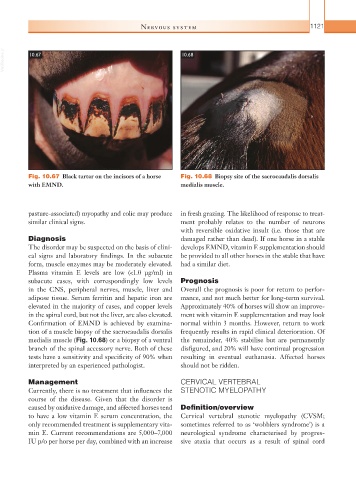Page 1146 - Equine Clinical Medicine, Surgery and Reproduction, 2nd Edition
P. 1146
Nervous system 1121
VetBooks.ir 10.67 10.68
Fig. 10.67 Black tartar on the incisors of a horse Fig. 10.68 Biopsy site of the sacrocaudalis dorsalis
with EMND. medialis muscle.
pasture-associated) myopathy and colic may produce in fresh grazing. The likelihood of response to treat-
similar clinical signs. ment probably relates to the number of neurons
with reversible oxidative insult (i.e. those that are
Diagnosis damaged rather than dead). If one horse in a stable
The disorder may be suspected on the basis of clini- develops EMND, vitamin E supplementation should
cal signs and laboratory findings. In the subacute be provided to all other horses in the stable that have
form, muscle enzymes may be moderately elevated. had a similar diet.
Plasma vitamin E levels are low (<1.0 µg/ml) in
subacute cases, with correspondingly low levels Prognosis
in the CNS, peripheral nerves, muscle, liver and Overall the prognosis is poor for return to perfor-
adipose tissue. Serum ferritin and hepatic iron are mance, and not much better for long-term survival.
elevated in the majority of cases, and copper levels Approximately 40% of horses will show an improve-
in the spinal cord, but not the liver, are also elevated. ment with vitamin E supplementation and may look
Confirmation of EMND is achieved by examina- normal within 3 months. However, return to work
tion of a muscle biopsy of the sacrocaudalis dorsalis frequently results in rapid clinical deterioration. Of
medialis muscle (Fig. 10.68) or a biopsy of a ventral the remainder, 40% stabilise but are permanently
branch of the spinal accessory nerve. Both of these disfigured, and 20% will have continual progression
tests have a sensitivity and specificity of 90% when resulting in eventual euthanasia. Affected horses
interpreted by an experienced pathologist. should not be ridden.
Management CERVICAL VERTEBRAL
Currently, there is no treatment that influences the STENOTIC MYELOPATHY
course of the disease. Given that the disorder is
caused by oxidative damage, and affected horses tend Definition/overview
to have a low vitamin E serum concentration, the Cervical vertebral stenotic myelopathy (CVSM;
only recommended treatment is supplementary vita- sometimes referred to as ‘wobblers syndrome’) is a
min E. Current recommendations are 5,000–7,000 neurological syndrome characterised by progres-
IU p/o per horse per day, combined with an increase sive ataxia that occurs as a result of spinal cord

